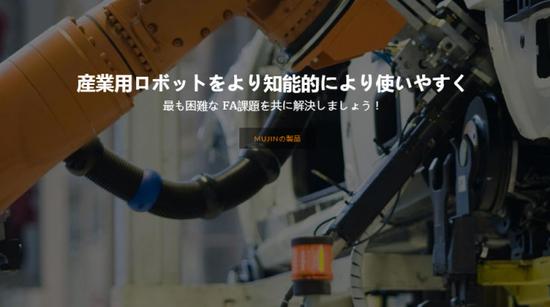Learn Japanese, how to make industrial robots better

MUJIN is a Japanese company focused on providing universal integrated solutions for industrial robots. It was founded in 2011. His founder, Issei Takino, a sales manager of Iscar, a precision tool manufacturer, has been rushing to factories in Japan, South Korea, and China for many years. This made him aware of the development trend of industrial robots as well as hidden problems.
In 2014, MUJIN won the UTEC (University of Tokyo Edge Capita) lead, JAFCO followed the investment of 6 million US dollars in Series B financing, JAFCO did not publicly announce the investment behavior for unknown reasons.
The trends seen by Issei Takino in 2011 were corroborated by securities industry analysts and policies. According to a report released by Fortune Securities, the total sales of global industrial robots reached 248,000 units in 2015, and it is predicted that this number will increase to 400,000 units in 2018. The Chinese government also responded to this trend last year: “The Robot Industry Development Plan (2016-2020)†pointed out that by 2020, the annual output of self-owned industrial robots will reach 100,000 units.
Contrary to market trends, it is still not an easy task for business owners to buy industrial robots. Lei Feng Network (public number: Lei Feng network) learned that, as far as the current status is concerned, the industry believes that the following defects exist in the application of industrial robots:
Poor ease of use
There are two ways for industrial robots to "work": one is a programming input type and the other is a teaching input type. Due to the complex structure of the robot, the front-line workers who use industrial robots undergo rigorous and complicated training and the operation is very tedious. This causes huge costs for the company.
Unable to deal with environmental changes
The biggest difference between robots and humans lies in the perception of the environment. Even though artificial intelligence has continued to develop in recent years, the perception of the environment by robots remains weak. Once the environment is mutated, it is very likely that the robot will cause large areas of paralysis and even cause factory safety accidents.
Security is doubtful
In the process of operation, industrial robots sometimes have actual contact with humans, especially cooperative robots. If there are security loopholes during design, they are hijacked by hackers, or calculation errors occur during motion planning, it is very prone to accidental injuries.
The core of these three issues is actually control.
To solve these problems, Issei Takino hired Rosen Diankov from Carnegie Mellon University to serve as the MUJIN CTO. Rosen Diankov is deeply involved in the field of motion planning. His doctoral thesis is centered on this issue. Perhaps many people do not know his name, but people engaged in this industry are basically inseparable from the open source project OpenRAVE, and Rosen Diankov is the founder and maintainer of this open source project.

From the official website of OpenRAVE, we can see that its goal is to automate industrial robots. This is in fact the same direction as MUJIN. It is believed that this is why Issei Takino can pull him into the company. In MUJIN's official website, Xinzhizhi also found that officials did not evade this, and generously acknowledged the importance of OpenRAVE for MUJIN:
1 2 Next>
Hot dip Galvanized Cable Tray is a type of cable management system used to support and organize electrical cables and wires in industrial and commercial settings. It is made of high-quality steel and is coated with a layer of zinc through a hot-dip galvanizing process. This process involves immersing the steel in a bath of molten zinc, which creates a durable and corrosion-resistant coating.
Hot dip galvanized cable trays come in various sizes and shapes, including ladder, perforated, and wire mesh. They are designed to withstand harsh environments, including exposure to chemicals, moisture, and extreme temperatures. This makes them ideal for use in outdoor applications, as well as in areas with high humidity or corrosive substances.
One of the key benefits of hot dip galvanized cable trays is their durability. The zinc coating provides excellent protection against rust and corrosion, ensuring that the trays can last for many years without needing to be replaced. They are also resistant to UV radiation, which can cause other types of cable trays to degrade over time.
Another advantage of hot dip galvanized cable trays is their versatility. They can be used in a wide range of applications, including power plants, oil and gas refineries, chemical processing facilities, and commercial buildings. They can be easily customized to meet specific requirements, such as the need for additional support or the ability to accommodate larger cables.
Hot dip galvanized cable trays are also easy to install and maintain. They can be mounted on walls, ceilings, or floors, and can be easily adjusted or moved as needed. They require minimal maintenance, as the zinc coating provides long-lasting protection against corrosion and other types of damage.
Hot Dip Galvanized Cable Tray,Hot Dip Galvanized Cable Ladder,Hot Dip Galvanized Trunking Cable Tray,Ladder Cable Tray
Rayhot Technology Group Co.,Ltd , https://www.cnrayhot.com